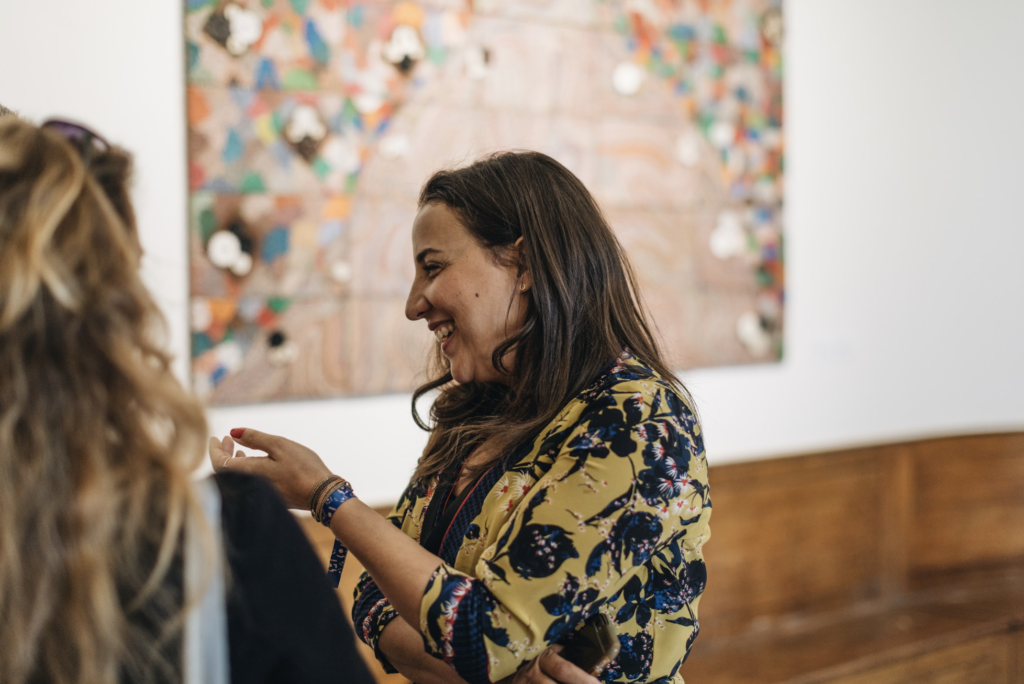1-54 is the first and only international fair devoted to contemporary African art, and it was established in 2013 by Touria El Glaoui. 1-54 is the top international art fair dedicated to giving contemporary art from Africa and its diaspora prominence. It holds three editions annually in London, New York, and Marrakech, as well as a pop-up fair in Paris. The fifty-four nations that make up the African continent are referenced in the name of the fair. Touria shares her inspiration behind the event and reflects on its growth over the years.
A.S: Can you share the inspiration behind founding the 1-54 Contemporary African Art Fair? What motivated you to create a platform specifically dedicated to showcasing African artists?
T.E: In 2013, when 1-54 was founded, the contemporary African art scene was burgeoning but this wasn’t necessarily being reflected on the international art fair circuit. I wanted to address that, and create a space for African and African diasporic artists’ work to be shown and engaged with in a meaningful way.

A.S: 1-54 has gained traction and has become a significant platform for contemporary African art on a global scale. What have been some of the most memorable milestones in this journey?
T.E: There have been so many significant moments along the way. Our ten year anniversary last year felt incredibly special as it was a chance to celebrate the artists, galleries, thinkers, curators and friends of the fair who have contributed to its development and success. The launch of 1-54 Presents, our programme of pop-up exhibitions, earlier this year was also an important milestone as the fair continues to grow and explore new opportunities.
A.S: The art world can be challenging to navigate, especially for artists from underrepresented regions. What criteria do you consider when curating the fair?
T.E: First and foremost we’re looking for quality, innovation, rigor and originality. For us, where an artist comes from will never limit their gallery’s application to the fair as we’re actively looking to shine a light on, engage with, and platform underrepresented cultures.

A.S: 1-54 has expanded to various international locations. How do you adapt the fair to suit the different cultural contexts and audiences while maintaining its core identity?
T.E: There are a number of steps we take to ensure that each edition of the fair feels unique and well suited to the city in which it takes place. The New York fair, for example, often features a greater number of African American artists, the aim being to open up dialogue on diaspora and cultural exchange. Marrakech is an incredibly collaborative city so for the Marrakech fair, which takes place at each February, we work with organizations like MACAAL and DaDa to present an expansive public programme that traverses the city’s rich cultural landscape. London is our flagship fair, and so we strive to ensure that the list of galleries and artists on view is as diverse as possible, with the aim of truly showcasing the breadth of talent coming from various creative hubs across Africa.
A.S: What are 3 words you would use to describe the art fairs from this year?
T.E: This year’s fairs have been expansive, innovative, and dynamic.

A.S: Through 1-54, you’ve built a community that joins artists, collectors, curators, and art enthusiasts. How do you envision the impact of African art when in conversation with the western world?
T.E: African art offers a unique perspective rooted in diverse cultural traditions, histories, and contemporary experiences, and so bringing African art into conversation with the Western world is key in fostering cross-cultural dialogue and mutual understanding. African art’s increasing visibility in the West and integration into the global contemporary art market is also creating greater professional and economic opportunities for artists working on the African continent.
A.S: Can you share a few pieces of artwork that have resonated with you that have been showcased in the fair? Or if there is one in particular that has left an impression.
T.E: Over the years there have been a number of memorable artworks, but I think those who had the opportunity to see it would agree that Grada Kilomba’s O Barco / The Boat, which was presented in the Somerset House courtyard on the occasion of our 10 year anniversary last year, was particularly moving. For me the installation, which was composed of 140 blocks of charred wood arranged into the shape of a boat, probed at the fraught history of colonialism and empire with incredible nuance and care. Experiencing the work was unforgettable.
A.S: As a leader and advocate for contemporary African art, what advice would you give to aspiring artists from Africa seeking to make an impact in the international art world?
T.E: Don’t be afraid to explore new ideas, themes and mediums. At present we’re seeing a lot of world class, incredibly impactful figurative painting coming from Africa, but figuration and portraiture are not the only ways to make an impact on the international art world. I’d encourage young artists to explore a variety of mediums, styles and themes early on. There’s more than one way to make an impact.
For more information on 1-54 Art Fair, you can check their website here, or their instagram account for updates here.


